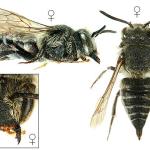Apis conica LINNAEUS 1758; Apis agilis HARRIS 1776; Apis acuminata GMELIN 1790; Apis bidentata PANZER 1798; Coelioxys acuta NYLANDER 1848; Coelioxys fissidens FÖRSTER 1853; Coelioxys fraterna FÖRSTER 1853; Coelioxys convergens SCHENCK 1855; Coelioxys truncata HÖPPNER 1901
A photographic test key by Rowson and Pavett is available via the BWARS website. Else and Edwards cover Coelioxys in their new book Handbook of the Bees of the British Isles, which is due for publication soon.
In Britain Coelioxys quadridentata is restricted to England and south Wales. There are no records for Scotland or Ireland. The greatest density of records is from Dorset and Surrey with more scattered records from the south-east up towards Yorkshire. The bee is also recorded from Jersey in the Channel Islands.
On the near continent, the bee is found in many western European countries (including Scandinavia) from Finland to Spain and across to Slovenia in the east. Worldwide it is found in Asia from Turkey to Siberia.
Shirt (1987) and Falk (1991) both list this bee as being Rare (RDB3).
Typical habitat includes sandy heaths and coastal dune systems (Else, in prep). However, it has been found in other situations, such as flying with Anthophora quadrimaculata (Panzer) against a wall at a Surrey railway station (D Baker, pers. obs. in Baldock, 2008).
A univoltine species flying from mid-June to early August.
The female of Coelioxys quadridentata is similar to most other Coelioxys species in that it has a pointed sixth tergite and sternite, designed to insert an egg into the host brood cell. Generally, Coelioxys larvae kill, and in some species eat, the host egg immediately on hatching. Pupation occurs within a cocoon spun within the host cell where the larva overwinters as a pre-pupa, prior to final pupation in spring of the following year. Anthophora quadrimaculata (Panzer) is known to be a host in Britain. M Edwards (pers. comm.) also reared quadridentata from the nest of Anthophora furcata (Panzer). Additional hosts reported from continental Europe include Megachile circumcincta (Kirby) and Megachile willughbiella (Kirby).
The bee is reported to forage from common bird’s-foot trefoil and white bryony.
No data available.
2016


